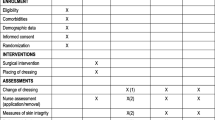Abstract
Background
Daily plastic surgery ward rounds involve regular complex wound monitoring to direct management. As a tertiary service, our patients are often located on different wards that lack a full gamut of dressings. We propose the use of a novel, expedient, temporary dressing for wound coverage and review the literature on the subject matter.
Methods
Our trauma team trialled the use of standard polyethylene aprons’ inner surface as temporary cover for open wounds. Microbiology wound swabs were taken from the unfolded apron prior to use, and sent for routine culture. Twenty-one consecutive patients were recruited to the trial. All patients were asked to rate the dressing on pain and comfort.
Results
No bacterial growth was reported. The average price of each apron is 3 pence and patients reported that their use was comfortable, painless and quick. The plastic apron was popular with our outreach nursing team (responsible for applying full dressings post ward round) who reported always finding one with ease.
Conclusions
Polyethylene aprons are widely available in all clinical areas. We found no evidence that they are colonised with or harbour bacteria at the point when taken from the roll. They are inexpensive, easy to handle, waterproof and in our experience, do not adhere to wounds. In addition, no specialty specific knowledge or training is required for their use. We believe these qualities make the polyethylene apron an ideal temporary dressing.
Level of Evidence: Level IV, therapeutic study



Similar content being viewed by others
References
NHS supply chain. 2017. Product details BTB090. [online] Available at http://supplychain.nhs.uk. Accessed 1 December 2017
Sood A, Granick M, Tomaselli N (2014) Wound dressings and comparative effectiveness data. Adv Wound Care 3(8):511–529
Leigh D, Petch V (1987) Sterility of incontinence pads and sheets. J Hosp Infect 9:91–93
Sprott MS, Kearns AM, Keenlyside D (1988) A microbiological study of absorbent pads. J Hosp Infect 12(2):125–129
Wilson G, French G (1987) Plasticised polyvinylchloride as a temporary dressing for burns. Br Med J (Clin Res Ed) 294(6571):556–557
Hudspith K, Rayatt S (2004) ABC of burns. First aid treatment of minor burns. Br Med J 328:1487–1489
www.polymeracademy.com. (2017). Polythelene chemical properties. [online] Available at http://www.polymeracademy.com. Accessed 1 December 2017
Medisave supply. (2017). medisave [online] Available at http://medisave.co.uk. Accessed 29 October 2017
'Thermoplastic'. Wikipedia, Wikimedia Foundation. Viewed 29 October 2017, from https://en.wikipedia.org/wiki/Thermoplastic
Author information
Authors and Affiliations
Corresponding author
Ethics declarations
Sources of financial support
None
Conflict of interest
Mr. Ammar Allouni and Miss Anna-Victoria Giblin declare that they have no conflict of interest.
Ethical approval
Ethical approval is not applicable and not required in this study.
Informed consent
Informed consent was obtained.
Rights and permissions
About this article
Cite this article
Allouni, A., Giblin, AV. The ubiquitous hospital polyethylene pinny: an ideal temporary wound cover. Eur J Plast Surg 41, 703–706 (2018). https://doi.org/10.1007/s00238-018-1437-9
Received:
Accepted:
Published:
Issue Date:
DOI: https://doi.org/10.1007/s00238-018-1437-9




